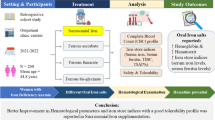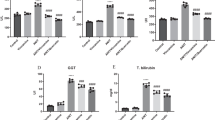Abstract
Iron is one of the most important essential elements for cell function. However, iron overload can exert destructive effects on various tissues, especially the liver. The present study was designed to evaluate the effect of thymoquinone (TQ) on hepatotoxicity induced by iron-overload in in vitro and mouse model. After in vitro studies, thirty mice were divided into five groups, six each. Group 1 received normal saline. Group 2 received five doses of iron dextran (i.p; 100 mg/kg, one dose every 2 days). Group 3 received TQ (orally, 2 mg/kg/day). Groups 4 and 5 were administrated iron dextran saline (i.p; 100 mg/kg, one dose every 2 days) following treatment with 0.5 and 2 mg/kg/day of TQ, respectively. Based on the findings of the DPPH experiment, although TQ has significant anti-radical potential, at a safe dose of 15 × 10+3 nM, it reduced the IC50 of iron dextran on HepG2 cells by about 25%, in in vitro. Following administration of low-dose TQ (0.5 mg/kg), a significant improvement was observed in serum hepatic enzymes activity and hepatic lipid peroxidation compared to iron dextran. However, administration of TQ-high dose (2 mg/kg) led to decrease antioxidant defense alongside increased serum hepatic enzymes and pathological damages in iron dextran–treated animals. Due to the different efficacy of TQ in treatment groups, it seems that the TQ therapeutic index is low and does not have significant safety in the iron overload status.








Similar content being viewed by others
Data Availability
All relevant data are within the paper.
References
Wojtunik-Kulesza K, Oniszczuk A, Waksmundzka-Hajnos M (2019) An attempt to elucidate the role of iron and zinc ions in development of Alzheimer’s and Parkinson’s diseases. Biomed Pharmacother 111:1277–1289
Basu T, Panja S, Shendge AK, Das A, Mandal N (2018) A natural antioxidant, tannic acid mitigates iron-overload induced hepatotoxicity in Swiss albino mice through ROS regulation. Environ Toxicol 33:603–618
Xie D, Zhou P, Liu L, Jiang W, Xie H, Zhang L, Xie D (2019) Protective effect of Astragaloside IV on hepatic injury induced by iron overload. BioMed research international 2019
Pari L, Karthikeyan A, Karthika P, Rathinam A (2015) Protective effects of hesperidin on oxidative stress, dyslipidaemia and histological changes in iron-induced hepatic and renal toxicity in rats. Toxicol Rep 2:46–55
Qi X, Zhang Y, Guo H, Hai Y, Luo Y, Yue T (2020) Mechanism and intervention measures of iron side effects on the intestine. Crit Rev Food Sci Nutr 60:2113–2125
Firozian F, Karami S, Ranjbar A, Azandaryani MT, Nili-Ahmadabadi A (2020) Improvement of therapeutic potential N-acetylcysteine in acetaminophen hepatotoxicity by encapsulation in PEGylated nano-niosomes. Life Sci 255:117832
Ghate NB, Chaudhuri D, Panja S, Mandal N (2015) Nerium indicum leaf alleviates iron-induced oxidative stress and hepatic injury in mice. Pharm Biol 53:1066–1074
Talaei R, Kheirollah A, Babaahmadi Rezaei H, Mansouri E, Mohammadzadeh G (2018) The protective effects of hydro-alcoholic extract of Coriandrum sativum in rats with experimental iron-overload condition. Jundishapur Journal of Natural Pharmaceutical Products 13
Güvendi GF, Eroğlu HA, Makav M, Güvendi B, Adalı Y (2020) Selenium or ozone: effects on liver injury caused by experimental iron overload. Life Sci 262:118558
Nili-Ahmadabadi A, Alibolandi P, Ranjbar A, Mousavi L, Nili-Ahmadabadi H, Larki-Harchegani A, Ahmadimoghaddam D, Omidifar N (2018) Thymoquinone attenuates hepatotoxicity and oxidative damage caused by diazinon: an in vivo study. Research in pharmaceutical sciences 13:500
Ahmad S, Beg ZH (2013) Hypolipidemic and antioxidant activities of thymoquinone and limonene in atherogenic suspension fed rats. Food Chem 138:1116–1124
Aboubakr M, Elshafae SM, Abdelhiee EY, Fadl SE, Soliman A, Abdelkader A, Abdel-Daim MM, Bayoumi KA, Baty RS, Elgendy E (2021) Antioxidant and anti-inflammatory potential of thymoquinone and lycopene mitigate the chlorpyrifos-induced toxic neuropathy. Pharmaceuticals 14:940
Kohandel Z, Farkhondeh T, Aschner M, Samarghandian S (2021) Anti-inflammatory effects of thymoquinone and its protective effects against several diseases. Biomed Pharmacother 138:111492
Abdel-Daim MM, El-Ela FIA, Alshahrani FK, Bin-Jumah M, Al-Zharani M, Almutairi B, Alyousif MS, Bungau S, Aleya L, Alkahtani S (2020) Protective effects of thymoquinone against acrylamide-induced liver, kidney and brain oxidative damage in rats. Environ Sci Pollut Res 27:37709–37717
Awad AS (2016) Abd Al Haleem EN, El-Bakly WM, Sherief MA: Thymoquinone alleviates nonalcoholic fatty liver disease in rats via suppression of oxidative stress, inflammation, apoptosis. Naunyn Schmiedebergs Arch Pharmacol 389:381–391
Asgharzadeh F, Bargi R, Beheshti F, Hosseini M, Farzadnia M, Khazaei M (2017) Thymoquinone restores liver fibrosis and improves oxidative stress status in a lipopolysaccharide-induced inflammation model in rats. Avicenna journal of phytomedicine 7:502
Mabrouk A (2017) Protective effect of thymoquinone against lead-induced antioxidant defense system alteration in rat liver. Acta Biol Hung 68:248–254
Mabrouk A, Salah IBH, Chaieb W, Cheikh HB (2016) Protective effect of thymoquinone against lead-induced hepatic toxicity in rats. Environ Sci Pollut Res 23:12206–12215
Zafeer MF, Waseem M, Chaudhary S, Parvez S (2012) Cadmium-induced hepatotoxicity and its abrogation by thymoquinone. J Biochem Mol Toxicol 26:199–205
Al Aboud D, Baty RS, Alsharif KF, Hassan KE, Zhery AS, Habotta OA, Elmahallawy EK, Amin HK, Moneim AEA, Kassab RB (2021) Protective efficacy of thymoquinone or ebselen separately against arsenic-induced hepatotoxicity in rat. Environ Sci Pollut Res 28:6195–6206
Pal RR, Rajpal V, Singh P, Saraf SA (2021) Recent findings on thymoquinone and its applications as a nanocarrier for the treatment of cancer and rheumatoid arthritis. Pharmaceutics 13:775
El-Shanshory M, Hablas NM, Aboonq MS, Fakhreldin AR, Attia M, Arafa W, Mariah RA, Baghdadi H, Ayat M, Zolaly M et al (2019) Nigella sativa improves anemia, enhances immunity and relieves iron overload-induced oxidative stress as a novel promising treatment in children having beta-thalassemia major. J Herbal Med 16:100245
Ebrahimifar M, Nili-Ahmadabadi A, Akbarzadeh A, Shahemabadi HE, Hasanzadegan M, Moradi-Sardareh H, Madadizadeh H, Rezaee-Diyan J (2017) Preparation, characterization and cytotoxic effects of pegylated nanoliposomal containing carboplatin on ovarian cancer cell lines. Indian J Clin Biochem : IJCB 32:230–234
Moradkhani S, Rezaei-Dehghanzadeh T, Nili-Ahmadabadi A (2020) Rosa persica hydroalcoholic extract improves cadmium-hepatotoxicity by modulating oxidative damage and tumor necrosis factor-alpha status. Environ Sci Pollut Res 27:31259–31268
El Nehir S, Karakaya S (2004) Radical scavenging and iron-chelating activities of some greens used as traditional dishes in Mediterranean diet. Int J Food Sci Nutr 55:67–74
Nili-Ahmadabadi A, Ali-Heidar F, Ranjbar A, Mousavi L, Ahmadimoghaddam D, Larki-Harchegani A, Ghafouri-Khosrowshahi A (2018) Protective effect of amlodipine on diazinon-induced changes on oxidative/antioxidant balance in rat hippocampus. Res Pharm Sci 13:368–376
Hu ML (1994) Measurement of protein thiol groups and glutathione in plasma. Methods Enzymol 233:380–385
Alvandi M, Dastan D, Soleimani Asl S (2020) The role of Allium saralicum extract on prevention of acetaminophen-induced hepatic failure: an experimental study. Res J Pharmacognosy 7:43–51
Shangari N, O’Brien PJ (2006) Catalase activity assays. Curr Protocols Toxicol 27:7.7.1-7.7.16
Koonyosying P, Tantiworawit A, Hantrakool S, Utama-Ang N, Cresswell M, Fucharoen S, Porter JB, Srichairatanakool S (2020) Consumption of a green tea extract–curcumin drink decreases blood urea nitrogen and redox iron in β-thalassemia patients. Food Funct 11:932–943
Kukreja A, Wadhwa N, Tiwari A (2013) Therapeutic role of natural agents in beta-thalassemia: a review. J Pharm Res 6:954–959
Khither H, Sobhi W, Khenchouche A, Mosbah A, Benboubetra M (2018) In-vitro antioxidant effect of thymoquinone. Annual Research & Review in Biology 1–9
Sandhya A, Kannayiram G (2020) Pharmacological, bioactive screening of medicinal plant nigella sativa and the derived compound thymoquinone: an invitro study. Int J Res Pharmaceut Sc 11:2458–2465
Darakhshan S, Pour AB, Colagar AH, Sisakhtnezhad S (2015) Thymoquinone and its therapeutic potentials. Pharmacol Res 95:138–158
Sarkar R, Hazra B, Mandal N (2012) Hepatoprotective potential of Caesalpinia crista against iron-overload-induced liver toxicity in mice. Evidence-Based Complementary and Alternative Medicine 2012
Omidifar N, Nili-Ahmadabadi A, Gholami A, Dastan D, Ahmadimoghaddam D, Nili-Ahmadabadi H (2020) Biochemical and histological evidence on the protective effects of Allium hirtifolium boiss (Persian Shallot) as an herbal supplement in cadmium-induced hepatotoxicity. Evidence-based complementary and alternative medicine 2020
Ghobadi S, Dastan D, Soleimani M, Nili-Ahmadabadi A (2019) Hepatoprotective potential and antioxidant activity of Allium tripedale in acetaminophen-induced oxidative damage. Res Pharma Sci 14:488
Ding H, Zhang Q, Yu X, Chen L, Wang Z, Feng J (2021) Lipidomics reveals perturbations in the liver lipid profile of iron-overloaded mice. Metallomics 13:mfab057
Nili-Ahmadabadi A, Tavakoli F, Hasanzadeh G, Rahimi H, Sabzevari O (2011) Protective effect of pretreatment with thymoquinone against Aflatoxin B1 induced liver toxicity in mice. Daru: J Faculty Pharma Tehran Univ Med Sci 19:282
Zeinvand-Lorestani H, Nili-Ahmadabadi A, Balak F, Hasanzadeh G, Sabzevari O (2018) Protective role of thymoquinone against paraquat-induced hepatotoxicity in mice. Pestic Biochem Physiol 148:16–21
Badria FA, Ibrahim AS, Badria AF, Elmarakby AA (2015) Curcumin attenuates iron accumulation and oxidative stress in the liver and spleen of chronic iron-overloaded rats. PLoS ONE 10:e0134156
Zhang X, Wu L, Zhen W, Li S, Jiang X (2021) Generation of singlet oxygen via iron-dependent lipid peroxidation and its role in Ferroptosis. Fundamental Research
Stoyanovsky D, Tyurina Y, Shrivastava I, Bahar I, Tyurin V, Protchenko O, Jadhav S, Bolevich S, Kozlov A, Vladimirov Y (2019) Iron catalysis of lipid peroxidation in ferroptosis: regulated enzymatic or random free radical reaction? Free Radical Biol Med 133:153–161
Lister INE, Ginting CN, Girsang E, Nataya ED, Azizah AM, Widowati W (2020) Hepatoprotective properties of red betel (Piper crocatum Ruiz and Pav) leaves extract towards H2O2-induced HepG2 cells via anti-inflammatory, antinecrotic, antioxidant potency. Saudi Pharmaceutical Journal 28:1182–1189
Badary OA, Taha RA, Gamal El-Din AM, Abdel-Wahab MH (2003) Thymoquinone is a potent superoxide anion scavenger. Drug Chem Toxicol 26:87–98
Martinovich G, Martinovich I, Vcherashniaya A, Shadyro O, Cherenkevich S (2016) Thymoquinone, a biologically active component of Nigella sativa, induces mitochondrial production of reactive oxygen species and programmed death of tumor cells. Biophysics 61:963–970
Mahmoud YK, Abdelrazek HM (2019) Cancer: Thymoquinone antioxidant/pro-oxidant effect as potential anticancer remedy. Biomed Pharmacother 115:108783
Ardiana M, Pikir B, Santoso A, Hermawan H, Al-Farabi M (2020) Effect of Nigella sativa supplementation on oxidative stress and antioxidant parameters: A meta-analysis of randomized controlled trials. The Scientific World Journal 2020
Funding
The financial support for conducting the research project “Evaluation of biochemical and histological effects of thymoquinone on iron-induced toxicity in male mice” was provided by the Vice-Chancellor of Research and Technology, Hamadan University of Medical Sciences, Hamadan, I.R. Iran (Grant No. 140003181967).
Author information
Authors and Affiliations
Contributions
Farzad Ghasemi helped in the bibliography, biochemical analysis, and did the work and drafted the manuscript as his Pharm. D thesis. Fatemeh Ghaffari contributed in performing in vitro studies. Navid Omidifar assisted in doing histopathological analyses. Masoumeh Taheri Azandaryani contributed in animal laparotomy surgery. Amir Nili-Ahmadabadi conceived and supervised the study and edited the manuscript and has been the supervisor of the thesis.
Corresponding author
Ethics declarations
Ethics Approval
The study was conducted based on the guidelines of the Declaration of Helsinki, and approved by the Ethics Committee of Hamadan University of Medical Sciences (approval number: IR.UMSHA.REC.1400.098).
Conflict of Interest
The authors declare no competing interests.
Additional information
Publisher’s Note
Springer Nature remains neutral with regard to jurisdictional claims in published maps and institutional affiliations.
Rights and permissions
About this article
Cite this article
Ghasemi, F., Ghaffari, F., Omidifar, N. et al. Hepatic Response to the Interaction Between Thymoquinone and Iron-Dextran: an In Vitro and In Vivo Study. Biol Trace Elem Res 201, 1358–1367 (2023). https://doi.org/10.1007/s12011-022-03249-9
Received:
Accepted:
Published:
Issue Date:
DOI: https://doi.org/10.1007/s12011-022-03249-9




